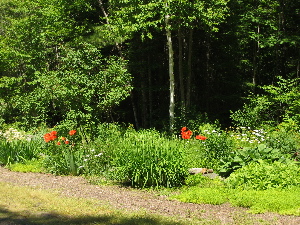I GUESS IT'S WINTER, FINALLY!
It's snowing again...which is nice to say this year. The ground, up until this week, has been brown, green, muddy and not very winter-like. But it has started snowing and our world is white as it should be in December. It appears that perhaps all is well here after all!
Christmas has come and gone. I've been spending some time working on that book I'm revising. I'm preparing for our New Year's morning "gathering", which is always fun. But I haven't posted anything to this blog for awhile. I apologize for that.
I have gotten the occasional question, to which I've responded. I've read all sorts of gardening articles talking about what gardeners talk about this time of year. Mostly catalogues!
Actually a few of them have talked about gardening resolutions for the new year and tips for what can be done right now in the garden. They've been interesting. Most of them are good common sense, but perhaps if you're a new gardener, you don't relate to them...YET!
Let me share a few of these wonderful articles with you. Here the first one:
"By resolving to stick to the following tips from the Plant Doctors at The American Phytopathological Society, you can enjoy healthy and beautiful plants all year long.
In the New Year, I resolve to:
- Mulch my perennials after the ground freezes to help them overwinter comfortably even though temperatures may fluctuate.
- When studying plant catalogs, look for pest- and disease-resistant plants, such as mildew-resistant phlox, Fusarium-resistant tomatoes and disease-resistant crabapples that will make my gardening job easier and keep my plants healthier.
- Send a soil sample to a laboratory to learn what my lime and fertilizer needs are, rather than guessing.
- Set plants in the ground only at the proper depth-deep planting harms roots and kills plants!
- Use only the well-drained areas of my garden for plants-unless I purchase some swamp-loving species!
- Inspect plants carefully before purchasing to find evidence of invaders such as spider mites, scale insects or mealybugs, or root swellings that might mean crown gall disease on plants such as flowering cherries or roses.
- Spread a circle of mulch around young trees to keep lawn mowers from damaging the bark, leading to canker diseases later on.
- Use only a few inches depth of mulch and keep it a few inches away from trunks and stems of plants to discourage crown rot.
- Scout regularly for symptoms in the garden, so that I can pick off the occasional spotted leaf before problems escalate.
- Irrigate new trees and shrubs the first two years especially during dry weather to help them establish good root systems.
- Use a soaker hose or some type of irrigation system for the flower beds and vegetable garden that won't wet the foliage and encourage leaf spots.
- Obtain a diagnosis when the cause of a problem is unclear or needs identification.
- Prune only in dry weather, especially when pruning plants prone to fire blight, such as pears, crabapples and hawthorns.
- Encourage beneficial insects and mites by minimizing use of broad- spectrum insecticides.
- Join a Master Gardener class to learn more about the fun of growing and maintaining plants.
Happy New Year and happy gardening from the Plant Doctors at The American Phytopathological Society!
The American Phytopathological Society (APS) is a non-profit, professional scientific organization."





0 Comments:
Post a Comment
<< Home